Key Points
The most common sign of a thyroid tumor is a swelling or lump in the neck region
Thyroid tumors usually are malignant and have a high tendancy to spread
Surgery is best suited for tumors that are freely moveable
Tumors that are invasive or fixed to the tissues of the neck should have radiation therapy
Chemotherapy is usually recommended as an adjunctive treatment for thyroid tumors
Download forms:
Introduction
Dogs have two thyroid glands that are located along side of the windpipe in the region of the neck. This gland produces thyroxine, a hormone that regulates the body’s metabolism. Thyroid tumors in dogs are relatively uncommon. Golden retrievers, Beagles, and Boxers between the ages of 9 and 11 are most common to develop this tumor. These tumors are almost always malignant, meaning that they tend to spread to the lungs and lymph nodes and can grow into nearby structures such as the windpipe, blood vessels and esophagus. At the time of diagnosis, 35 to 40% of the dogs will have visible evidence of spread of the tumor to other parts of the body (especially the lungs). As high as 60% of dogs will have the cancer affect both thyroid glands, which causes the glands to malfunction in 50% of these cases. In about 10% of the cases, the tumor will produce excessive amounts of thyroid hormone which can have systemic side effects.
Signs and Diagnosis
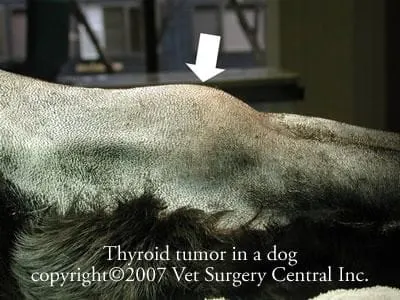
A complete blood count, chemistry profile and urine testing are completed in the initial stages of the evaluation of the patient that has a suspected thyroid tumor. Blood tests can be run to see if the thyroid glands are functioning normally or are hyperactive. A fine needle biopsy of the tumor provides a diagnosis about 50% of the time. Ultrasound of the neck frequently can show the extent of the tumor and demonstrate if the tumor has spread to lymph nodes in the neck. Chest x-rays are important to rule out visible spread of tumor to the lungs.
The Day of Surgery
In preparation for surgery, your pet should be fasted starting at 10 PM the night before surgery, however water does not need to be with held. To help prevent heartburn after surgery, a single dose of Pepcid AC (10 mg tablet per 20 pounds of body weight) should be administered at 6 AM at home on the day of surgery. Our anesthesia and surgical team will prescribe a pain management program, both during and after surgery, that will keep your companion comfortable. This will include a combination of general anesthesia, injectable analgesics, and oral analgesics.
Treatment
It has been estimated that only 25 to 50% of patients that are presented with a thyroid tumor are candidates for surgery. Only tumors that are not attached to the underlying tissues in the neck should be attempted to be removed. Providing that no visible spread of the tumor can be detected, dogs that have a freely moveable tumor removed can expect to live for another 3 years versus about 6 to 12 months for tumors that are invasive and fixed to underlying tissues.
Radiation therapy is used to treat thyroid cancer that is invasive into underlying tissues. Even with these aggressive tumors, the prognosis still can be favorable with 72% of the patients reported to survive 3 years following treatment, providing that there is no visible metastasis.
Following removal of these thyroid tumors, chemotherapy is definitely indicated if the resected mass is larger than 100 cm3, as the spread rate approaches 100% in these cases. Thyroid tumors tend to be partially responsive to chemotherapy, therefore, there is value in this treatment modality. Unlike humans, most dogs receiving chemotherapy do not loose their hair and usually have only mild side effects, which may include transient loss of appetite and vomiting.
Treatment with radioactive iodine can be successfully used to treat some thyroid tumors. Since this treatment requires a high dose of radioactive iodine, most hospitals do not offer this treatment due to staff safety concerns.
The tumor (labeled) has been approached via an incision made along the underside of the neck, over the windpipe. The muscles are separted and the tumor is exposed.
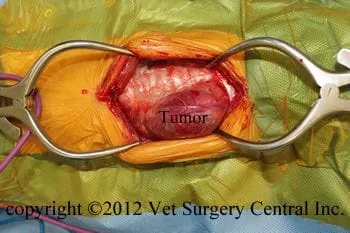
Thyroid tumors have a tremendous blood supply, therefore the use of a specialized cautery machine called the ligasure makes surgical removal of these tumors relatively bloodless.

The opposite thyroid gland is examined for tumor. Some cases will have bilateral tumors.
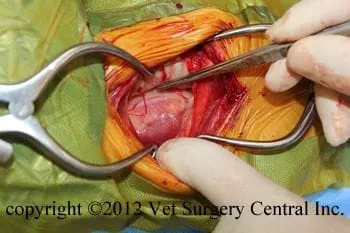
After the thyroid gland has been removed, it is measured in three dimensions using a calliper.
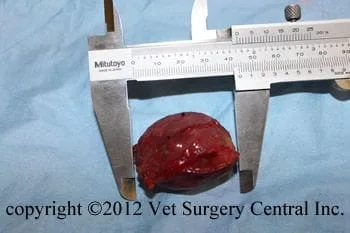
A graduated cylinder can be used to estimate the tumor volume, a predictor of patient suvival. 300 mL of water has been put in the cylinder.

The final volume with the tumor in the graduated cylinder is 325 mL. Do the math: 325-300 mL is 25. A close estimate of tumor volume is therefore 25 cm3.
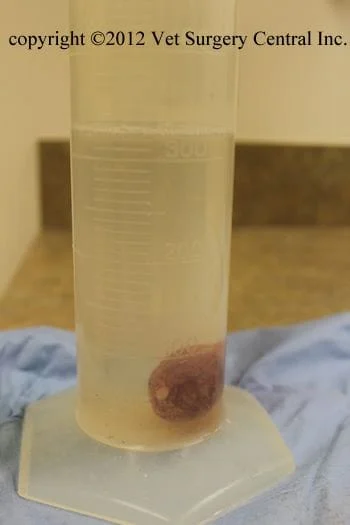
Aftercare
After surgery, you can continue to give your pet a prescribed pain reliever to minimize discomfort. Patients that have small thyroid tumors typically can go home on the day of surgery. In order to minimize bruising and swelling of the surgical site, apply a cold pack to the neck 20 minutes per session for four sessions daily during the first three days after surgery. Do not allow your dog to scratch the incision on the neck. If necessary the neck can be bandaged by one of our doctors to protect the incision. Use a harness to walk your dog instead of a collar so that no pressure is applied to the incision. Your pet may develop a fluid pocket in the region of the surgical site called a seroma, however, the body usually will naturally resorb the fluid over one month after surgery; restricting your dog’s activity for three weeks after surgery will help minimize this complication.
If your companion is recovering well following surgery and no complications develop, the healing process will be monitored by the surgeon with one follow-up exam scheduled two weeks after the surgery. Chemotherapy can initiated by our oncologist two weeks after surgery or at the time of radiation therapy. A thyroid hormone panel should be done in about 1 month after surgery to make sure that the remaining thyroid gland is functional.
References
- Carver JR, Kaptakin A, Patnaik AK. A comparison of medullary and thyroid adenocarcinomas in 38 dogs. Vet Surg 1995;24:315-319.
- Slensky KA, Volk SW, Schwarz T, et al . Acute severe hemorrage secondary to arterial invasion in a dog with thyroid carcinoma. J Am Vet Med Assoc 2003; 223:649-653.
- Fineman LS, Hamilton TA, de Gortari A, et al. Ciplastin chemotherpay for treatment of thyroid carcinoma in dogs: 13 cases. J Am Anim Hosp Assoc 1998; 34:109-12.
- Harari J, Patterson JS, Rosenthal RC. Clinical and pathologic features of thyroid tumors in 26 dogs. J Am Vet Med Assoc 1986; 188(10):1160- 1164.
- Kent MS, Griffey SM, Verstaete FJM, et al. Computer-assisted image analysis of neovascularization in thyroid neoplasms from dogs. Am J Vet Res 2002; 63:363-369.
- Greco DS. Endocrine emergencies. Part II Adrenal, thyroid and parathyroid disorders. Comp Cont Ed Vet 1997; 19(1)
- Mayer MN, MacDonald VS. External beam radiation therapy for thyroid cancer in the dog. Can Vet J 2007;48: 761-763.
- Turrell JM, McEntee MC, Burke BP, Page RL. Sodium iodide I 131 treatment of dogs with nonresectable thyroid tumors: 39 cases (1990-2003). J Am Vet Med Assoc 2006;229:542-548.
- Theon AP, Marks SL, Feldman ES, GBriffey S. Prognostic factors and patterns of treatment failur in dogs with unresectable differentiated thyroid carcinomas treated with megavoltage irradiation. J Am Vet Med Assoc 2000; 216:1775-1779.
- Radlinsky MG. Thyroid surgery in dogs and cats. Vet Clin Small Anim 2007; 37:789-798.
- Barber LG. Thyroid tumors in dogs and cats. Vet Clin Small Anim 2007; 37:755-773.
- Klein MK, Powers BE. Withrow SJ, et al. Treatment of thyroid carcioma in dogs by surgical resection alone: 20 cases (1981-1989) J Am Vet Med Assoc 1995; 2006(7): 1007-1009.
- Withrow SJ, Vail D. Tumors of the Endocrine System in Small Animal Clinical Oncology pp 591-608.
- Pack LA, Roberts RE, Dawson SD, Dookwah HD. Definitieve radiation therapy for infiltrative thyroid carcinoma in dogs. Vet Radiology Ultrasound, 42(5):471-474, 2001.


